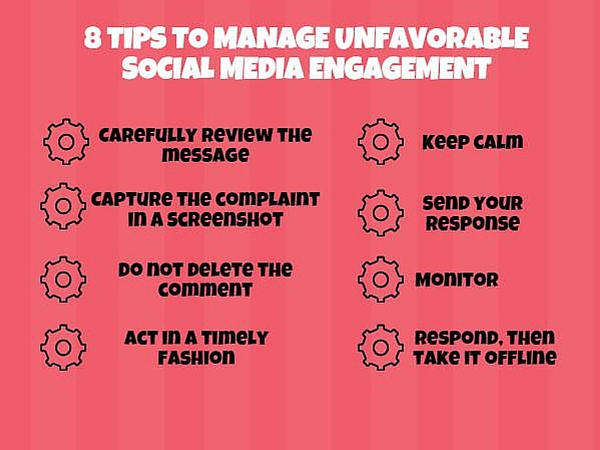
8 TIPS TO MANAGE UNFAVORABLE SOCIAL MEDIA ENGAGEMENT
Occasional negative comments and reviews are an unfortunate reality for robust brands with a vibrant social media presence. While it can be cumbersome, it’s also a unique opportunity to provide top-notch customer service and address issues or questions that have been elevated to social media. Whether it’s through a public avenue, like a reply to a Facebook comment or tweet, or through a private manner like a phone call or personal message, prompt responses are very important. You’ll want to ensure your answer is skillfully constructed, as well. So, you may be wondering, what are the best practices for managing negative social media comments?
- Carefully read the message. Multiple times. Make sure you understand what the problem is and check in with any relevant parties who may have already interacted with this customer in person. Do you know if this occurred specifically in the Charlotte, North Carolina branch? Check with the Charlotte manager and get background on the problem.
- Capture the complaint in a screenshot. It’s a good idea to keep track of such mentions, and it could be useful for an individual who may be following up with the customer.
- Do not delete the comment. It may be tempting to try to cover up these negative mentions, but transparency is key. Addressing issues head-on shows you have nothing to hide and are committed to providing a resolution for relevant parties. There are exceptions, if a post is inappropriate or vulgar, you may choose to reply and hide or delete it.
- Act in a timely fashion. Customers expect a prompt response, so you’ll need to move quickly. Aim to have a response posted an hour after the grievance first occurred.
- Keep calm. Although you’re acting in a different avenue, adhere to all the tenets of providing quality customer service. It’s important to remember that all your brand’s social media followers will be able to access your response to the disgruntled customer. Craft the response as carefully as you would a statement to a customer in person or a typical outgoing message.
- Send your response. This is your opportunity to engage in a dialogue with the customer, so provide an apology and a solution if that’s possible.
- Monitor. Your job is never fully complete! Make sure to monitor for additional comments from the customer. Once the issue is resolved, you may want to even post a closing response to let your followers know the problem has been handled, like “Hey Ms. Smith, we’re so happy we were able to help you. As always, reach out if you ever have questions or concerns.”
- Respond, then take it offline. Show that you’re addressing concerns but don’t create a back and forth battle. Link to an established customer service website, provide a hotline or ask the customer to send you a private message with their personal contact information and additional details so you can address their concerns.
